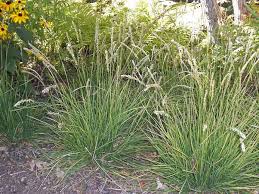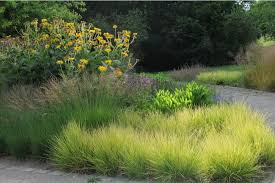Sesleria Autumnalis Grass, also known by its scientific name, Sesleria autumnalis, is a special kind of plant that grows in many parts of Europe. This type of grass is loved for its unique appearance and the way it changes with the seasons.
During the warmer months, Sesleria Autumnalis Grass has lovely green leaves that cover the ground like a soft carpet. These leaves are quite thin and delicate, giving the grass a fine and graceful look. As the name suggests, this grass truly shines in the autumn. When the weather starts to cool down, the leaves turn a beautiful shade of bronze or purple, adding a touch of warmth to gardens and landscapes.
Sesleria Autumnalis Grass is quite small in size, usually growing to be about 12 to 18 inches tall. This makes it perfect for bordering gardens or adding a touch of color to rockeries. It’s a tough plant that doesn’t need a lot of care, which makes it a favorite for those who want a low-maintenance garden.
Gardeners and nature enthusiasts enjoy planting Sesleria Autumnalis Grass because it can thrive in different types of soil and doesn’t need a lot of water. This grass prefers sunny spots but can tolerate some shade too. It’s also a great choice for attracting birds and insects to your garden, as they find its seeds and flowers quite appealing.
In addition, Sesleria Autumnalis Grass is a wonderful plant that brings beauty to gardens throughout the year. Its scientific name might sound complex, but its simple care requirements and stunning color changes make it a popular choice for both beginner and experienced gardeners alike.
Read Also: Grading, Storage and Marketing of Dry Cocoa Beans
Growing Sesleria Autumnalis Grass

Here’s a simple growing guide for Sesleria Autumnalis Grass:
1. Location: Choose a sunny to partially shaded spot in your garden for planting Sesleria Autumnalis Grass. It can tolerate some shade, but it will grow best with a good amount of sunlight.
2. Soil: This grass is not too picky about soil type, but well-draining soil is important to prevent waterlogging. If your soil is heavy and doesn’t drain well, you can amend it with some compost to improve drainage.
3. Planting: You can plant Sesleria Autumnalis Grass in the spring or fall. Dig a hole that’s about twice the size of the root ball of the plant. Place the plant in the hole and backfill with soil, gently patting it down as you go.
4. Watering: While Sesleria Autumnalis Grass is drought-tolerant once established, it’s important to keep the soil consistently moist during the first few weeks after planting. Water it regularly until you see new growth.
5. Mulching: Applying a layer of mulch around the base of the plant can help retain moisture and keep weeds at bay. Make sure to keep the mulch away from the crown of the plant to prevent rot.
6. Maintenance: This grass doesn’t require a lot of maintenance. Trim back any dead or damaged leaves in the spring to encourage new growth. If the grass starts to look untidy, you can give it a light trim to tidy it up.
7. Fertilizing: Sesleria Autumnalis Grass doesn’t need a lot of fertilizer. You can apply a balanced, slow-release fertilizer in the spring, but avoid over-fertilizing as it can cause the grass to become leggy.
8. Propagation: If you want to propagate the grass, you can divide established clumps in the spring or fall. Gently dig up the clump and separate the sections, then replant them in their desired spots.
9. Seasonal Changes: One of the highlights of Sesleria Autumnalis Grass is its autumn color change. As the weather cools down, the leaves will turn bronze or purple. Enjoy this beautiful transformation!
10. Pest and Disease: This grass is generally resistant to pests and diseases. However, keeping an eye out for any signs of damage or unusual growth is always a good practice.
Remember, every garden is unique, so it’s a good idea to observe how your Sesleria Autumnalis Grass responds to its environment and adjust your care routine accordingly. With a little attention and care, you can enjoy the beauty of this charming grass in your garden throughout the year.
Caring for Sesleria Autumnalis Grass

Here’s a simple care guide for Sesleria Autumnalis Grass:
1. Watering: Water the grass regularly during its first growing season to help establish its root system. Once it’s established, Sesleria Autumnalis Grass is quite drought-tolerant and generally doesn’t need frequent watering. Water deeply when the soil feels dry to the touch.
2. Sunlight: Plant the grass in a location where it can receive full sun to partial shade. It can tolerate some shade, but its color and overall appearance will be best in sunnier spots.
3. Soil: This grass is adaptable to various soil types, but it prefers well-draining soil. Make sure the soil doesn’t become waterlogged, as overly wet conditions can lead to root rot.
4. Mulching: Applying a layer of mulch around the base of the plant can help retain soil moisture and prevent weed growth. Avoid piling the mulch against the grass stems, as this can encourage disease.
5. Pruning: In late winter or early spring, trim back any dead or damaged leaves from the previous season. This will help promote new growth and keep the plant looking neat.
6. Fertilizing: Sesleria Autumnalis Grass doesn’t require heavy fertilization. A light application of a balanced, slow-release fertilizer in the spring can provide nutrients for healthy growth. Avoid excessive fertilizing, as it can lead to overly lush growth.
7. Division: If the grass becomes too crowded or you’d like to propagate it, consider dividing the clumps every few years. Spring or early fall is the best time for division. Dig up the clump, separate the sections, and replant them with adequate spacing.
8. Winter Care: This grass is quite hardy, but providing a layer of mulch around its base in late fall can help protect its roots during the colder months.
9. Pest and Disease: Sesleria Autumnalis Grass is generally resistant to pests and diseases. However, it’s a good practice to regularly inspect your plants for any signs of issues and address them promptly if they arise.
10. Appreciate Seasonal Changes: One of the unique features of this grass is its autumn color change. Enjoy the beauty of the bronze or purple hues that appear as the weather cools down.
Remember that each garden and environment can be different, so observe how your Sesleria Autumnalis Grass responds to the care you provide and make adjustments as needed. With its low-maintenance nature, this grass can be a lovely addition to your landscape.
Read Also: Products That Can Be Made From Cocoa
Importance of Sesleria Autumnalis Grass
Sesleria Autumnalis Grass holds significance for several reasons:
1. Ornamental Value: The unique color changes of Sesleria Autumnalis Grass as the seasons transition make it a popular choice for adding visual interest to gardens, landscapes, and ornamental plantings.
2. Low Maintenance: Its adaptability to various soil types, drought tolerance, and minimal care requirements make Sesleria Autumnalis Grass an attractive option for both beginner and experienced gardeners looking for easy-to-maintain plants.
3. Erosion Control: The dense growth habit of this grass helps stabilize soil and prevent erosion on slopes, banks, and areas prone to soil movement.
4. Wildlife Habitat: The grass’s seeds and flowers can attract birds and insects, contributing to biodiversity and providing a food source for local wildlife.
5. Naturalization: Sesleria Autumnalis Grass can be used in naturalized landscapes, meadows, and native plant gardens to create a more ecological and sustainable environment.
6. Garden Design: Its small size and fine texture make it suitable for border plantings, edging, rock gardens, and mixed beds, adding a touch of elegance to various garden designs.
7. Educational Value: This grass can serve as a learning tool for understanding plant adaptations, seasonal changes, and the role of native plants in supporting local ecosystems.
8. Climate Resilience: Its ability to thrive in various conditions, including dry spells, contributes to garden sustainability in regions with unpredictable or changing climates.
9. Aesthetic Diversity: Sesleria Autumnalis Grass introduces a distinctive visual element to landscapes, diversifying plant palettes and creating eye-catching focal points.
10. Cultural and Historical Significance: Native to certain parts of Europe, Sesleria Autumnalis Grass may hold cultural or historical significance in certain regions due to its local presence.
In summary, Sesleria Autumnalis Grass offers not only aesthetic beauty but also practical benefits, from erosion control to supporting wildlife. Its adaptability and low-maintenance nature make it a versatile and valuable addition to various landscapes and gardening contexts.
Read Also: A Comprehensive Guide To Circular Economy Consulting
